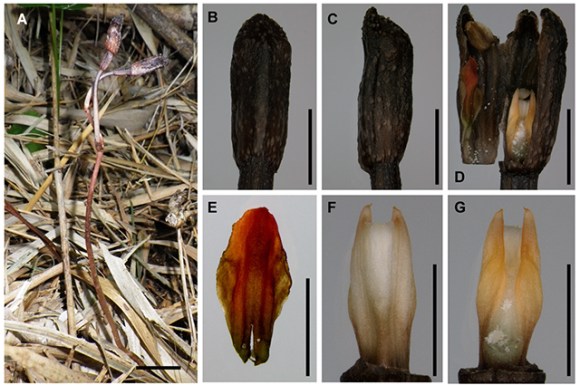 On 7 November Kenji Suetsugu, a researcher at Kyoto University announced that he discovered a brand new type of orchid. The flower was found in April of last year on the island of Takeshima (not the same Takeshima that’s in dispute between Japana and Korea) in Kagoshima Prefecture.
On 7 November Kenji Suetsugu, a researcher at Kyoto University announced that he discovered a brand new type of orchid. The flower was found in April of last year on the island of Takeshima (not the same Takeshima that’s in dispute between Japana and Korea) in Kagoshima Prefecture.
Not only is finding a new species of plant a rare occurrence, but this particular orchid is quite unique in that it neither requires photosynthesis to live nor does it bloom at all.
Scientist, Kenji Suetsugu, found around one hundred of these interesting yet unappealing flowers, named Gastrodia takeshimensis, growing wild in a bamboo grove during a research trip. This was lucky since this particular orchid spends most of it’s time underground and only comes out for about a month in the springtime. The rest of the time it feeds off a supply of nutrition taken from fungi attached to its roots.
Such behavior has deemed it worthy of the nickname “NEET of the plant kingdom” by some netizens. Some were concerned that the anti-social behavior of fully grown organisms refusing to go outside most of the year has now spread to vegetation in Japan as well.
For that brief period in the spring the stem of Gastrodia takeshimensis extends about seven to 16 centimeters from the ground. It’s believed this behavior protects it from being eaten by animals. However, even while it’s out of the ground, this orchid remains closed and never blooms.
The very unplantlike combination of never blooming and never using photosynthesis is shared by only one other plant, the Gastrodia clausa. Suetsugu says his next goal is to understand what conditions caused this species to come about.
In total, there are about 50 species of Gastrodia orchids, nine of which can now be found in Japan, and none of which it seems would really brighten up your kitchen much.
Source: Annales Botanici Fennica (English/pdf), Mainichi Shimbun via Hachima Kiko (Japanese)
Image: Kyoto University
Takeshima Island

 Try not to chuckle about this important Japanese discovery regarding great tits (the birds)
Try not to chuckle about this important Japanese discovery regarding great tits (the birds) Large bat species discovered to be breeding in Japan for the first time
Large bat species discovered to be breeding in Japan for the first time This jellyfish may only exist in Japanese aquariums, remains undiscovered in the wild
This jellyfish may only exist in Japanese aquariums, remains undiscovered in the wild New species of mayfly discovered in Fukushima that can never get their prescription glasses
New species of mayfly discovered in Fukushima that can never get their prescription glasses Living tree bridges and other breathtaking scenery at the rainiest place on Earth
Living tree bridges and other breathtaking scenery at the rainiest place on Earth Japanese ramen restaurants under pressure from new yen banknotes
Japanese ramen restaurants under pressure from new yen banknotes McDonald’s new Happy Meals offer up cute and practical Sanrio lifestyle goods
McDonald’s new Happy Meals offer up cute and practical Sanrio lifestyle goods New private rooms on Tokaido Shinkansen change the way we travel from Tokyo to Kyoto
New private rooms on Tokaido Shinkansen change the way we travel from Tokyo to Kyoto A trip to hell on Japan’s ‘vomit ship’: Is it as bad as everyone says it is?
A trip to hell on Japan’s ‘vomit ship’: Is it as bad as everyone says it is? French Fries Bread in Tokyo’s Shibuya becomes a hit on social media
French Fries Bread in Tokyo’s Shibuya becomes a hit on social media We tried Korea’s way-too-big King Tonkatsu Burger at Lotteria 【Taste Test】
We tried Korea’s way-too-big King Tonkatsu Burger at Lotteria 【Taste Test】 Sakura tree falls on man at Sannenzaka near Kiyomizu temple in Kyoto 【Breaking News】
Sakura tree falls on man at Sannenzaka near Kiyomizu temple in Kyoto 【Breaking News】 Secret Kitchen bento serves Japanese flowers, birds, wind and moon in a box, but is it worth it?
Secret Kitchen bento serves Japanese flowers, birds, wind and moon in a box, but is it worth it? Fire away your frustration at ‘404 Not Found’ — Site turns error message into classic arcade game
Fire away your frustration at ‘404 Not Found’ — Site turns error message into classic arcade game Is Japan’s massive Shizuoka steak sandwich really as delicious as it looks in promo photos?
Is Japan’s massive Shizuoka steak sandwich really as delicious as it looks in promo photos? All-you-can-drink Starbucks and amazing views part of Tokyo’s new 170 meter-high sky lounge
All-you-can-drink Starbucks and amazing views part of Tokyo’s new 170 meter-high sky lounge More foreign tourists than ever before in history visited Japan last month
More foreign tourists than ever before in history visited Japan last month Starbucks reopens at Shibuya Scramble Crossing with new look and design concept
Starbucks reopens at Shibuya Scramble Crossing with new look and design concept Disney princesses get official manga makeovers for Manga Princess Cafe opening in Tokyo
Disney princesses get official manga makeovers for Manga Princess Cafe opening in Tokyo Studio Ghibli releases new action figures featuring Nausicaä of the Valley of the Wind characters
Studio Ghibli releases new action figures featuring Nausicaä of the Valley of the Wind characters Beautiful new Final Fantasy T-shirt collection on the way from Uniqlo【Photos】
Beautiful new Final Fantasy T-shirt collection on the way from Uniqlo【Photos】 Is the new Shinkansen Train Desk ticket worth it?
Is the new Shinkansen Train Desk ticket worth it? Studio Ghibli glasses cases let anime characters keep an eye on your spectacles
Studio Ghibli glasses cases let anime characters keep an eye on your spectacles Studio Ghibli releases Kiki’s Delivery Service chocolate cake pouches in Japan
Studio Ghibli releases Kiki’s Delivery Service chocolate cake pouches in Japan New definition of “Japanese whiskey” goes into effect to prevent fakes from fooling overseas buyers
New definition of “Japanese whiskey” goes into effect to prevent fakes from fooling overseas buyers Our Japanese reporter visits Costco in the U.S., finds super American and very Japanese things
Our Japanese reporter visits Costco in the U.S., finds super American and very Japanese things Studio Ghibli unveils Mother’s Day gift set that captures the love in My Neighbour Totoro
Studio Ghibli unveils Mother’s Day gift set that captures the love in My Neighbour Totoro Domino’s Japan now sells…pizza ears?
Domino’s Japan now sells…pizza ears? New Japanese KitKat flavour stars Sanrio characters, including Hello Kitty
New Japanese KitKat flavour stars Sanrio characters, including Hello Kitty New Pokémon cakes let you eat your way through Pikachu and all the Eevee evolutions
New Pokémon cakes let you eat your way through Pikachu and all the Eevee evolutions Sales of Japan’s most convenient train ticket/shopping payment cards suspended indefinitely
Sales of Japan’s most convenient train ticket/shopping payment cards suspended indefinitely Sold-out Studio Ghibli desktop humidifiers are back so Totoro can help you through the dry season
Sold-out Studio Ghibli desktop humidifiers are back so Totoro can help you through the dry season Japanese government to make first change to romanization spelling rules since the 1950s
Japanese government to make first change to romanization spelling rules since the 1950s Ghibli founders Toshio Suzuki and Hayao Miyazaki contribute to Japanese whisky Totoro label design
Ghibli founders Toshio Suzuki and Hayao Miyazaki contribute to Japanese whisky Totoro label design Doraemon found buried at sea as scene from 1993 anime becomes real life【Photos】
Doraemon found buried at sea as scene from 1993 anime becomes real life【Photos】 Tokyo’s most famous Starbucks is closed
Tokyo’s most famous Starbucks is closed One Piece characters’ nationalities revealed, but fans have mixed opinions
One Piece characters’ nationalities revealed, but fans have mixed opinions We asked a Uniqlo employee what four things we should buy and their suggestions didn’t disappoint
We asked a Uniqlo employee what four things we should buy and their suggestions didn’t disappoint Princesses, fruits, and blacksmiths: Study reveals the 30 most unusual family names in Japan
Princesses, fruits, and blacksmiths: Study reveals the 30 most unusual family names in Japan Japan’s newly identified species of flatworm is reminding people of octopus wieners
Japan’s newly identified species of flatworm is reminding people of octopus wieners Miyazaki’s new animated short Boro the Caterpillar completed, voice actor revealed
Miyazaki’s new animated short Boro the Caterpillar completed, voice actor revealed First new Japanese cockroach species in 35 years discovered by scientists【Photos】
First new Japanese cockroach species in 35 years discovered by scientists【Photos】 Plant fukubukuro turns our apartment into an indoor garden for New Year
Plant fukubukuro turns our apartment into an indoor garden for New Year These cats “knead” you to show them some love【Video】
These cats “knead” you to show them some love【Video】 Cup Noodle releases new Rare Species Mystery Meat flavor, and we brave it with a taste test
Cup Noodle releases new Rare Species Mystery Meat flavor, and we brave it with a taste test Three centipede and cockroach species are newly named and placed under protection in Okinawa
Three centipede and cockroach species are newly named and placed under protection in Okinawa That moment when one successful manga artist quakes in the presence of another
That moment when one successful manga artist quakes in the presence of another Unusual guardians appear at Kyoto’s Kiyomizudera temple
Unusual guardians appear at Kyoto’s Kiyomizudera temple Parrot perched on a door in Japan forgets how to be a bird, remembers how to be awesome 【Video】
Parrot perched on a door in Japan forgets how to be a bird, remembers how to be awesome 【Video】 Vegetables are smarter than fruits: Three high IQ Japanese veggies
Vegetables are smarter than fruits: Three high IQ Japanese veggies The long road of the Chusonji Lotus spans nearly a millennium of Japanese history
The long road of the Chusonji Lotus spans nearly a millennium of Japanese history Japanese stationery now sprouts herbs in your garden with the Blooming Pencil
Japanese stationery now sprouts herbs in your garden with the Blooming Pencil Diarrhea-inducing mushrooms send three Japanese men to hospital after weekend-ruining barbecue
Diarrhea-inducing mushrooms send three Japanese men to hospital after weekend-ruining barbecue Arashiyama bamboo forest in Kyoto “crying” as tourists vandalise trees
Arashiyama bamboo forest in Kyoto “crying” as tourists vandalise trees
Leave a Reply